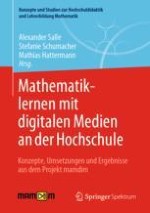2021 | OriginalPaper | Chapter
8. Wann und wie lange kommunizieren Studienanfängerinnen und -anfänger beim paarweisen Lernen mit digitalen Instruktionsmaterialien?
Zeitliche Aspekte des Kommunikationsverhaltens von Studienanfängerinnen und -anfängern beim Lernen mit und ohne fokussierende Fragen
Authors : Alexander Salle, Stefanie Schumacher
Published in: Mathematiklernen mit digitalen Medien an der Hochschule
Publisher: Springer Fachmedien Wiesbaden
Activate our intelligent search to find suitable subject content or patents.
Select sections of text to find matching patents with Artificial Intelligence. powered by
Select sections of text to find additional relevant content using AI-assisted search. powered by
